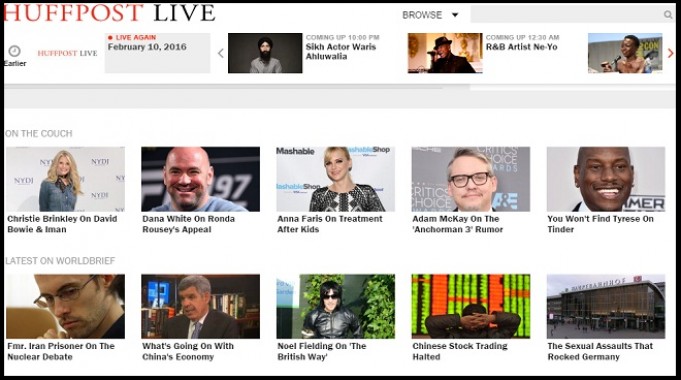HuffPost Live bites the dust
Washington, February 10: The decision by Huffington Post to consolidate its video operations reflects the brutal reality of today’s media environment - if you don’t change in time, you are constantly late to the party.
“HuffPost Live will no longer broadcast eight hours a day, but will go live for major news events and headline-making celebrity interviews that it has become known for,” a spokeswoman told reporters, referring to the Huffington Post’s internet-based video streaming network, launched in 2012. HuffPost Live’s shiny studios have already seen lay-offs but the spokeswoman insisted they affect less than one percent of the workforce.
But the “official” HuffPost Live story is generally always at variance with reality. Even before the latest “consolidation,” lay-offs, the burnout factor and the frenetic pace led to nearly two dozen employees leaving the organization last year.
The latest move appears to be part of a larger strategy of going global and preparing for the “post social” world, which has been defined by CEO Jared Grusd as a time when things come full circle and where people move from merely sharing to consuming all content they need from a site.
There is evidence that the digital empire built by Arianna Huffington mostly on the backs of unpaid bloggers felt the strain as traffic moved last year to newer, more dynamic sites such as Vox, Vice, and Buzzfeed in the US market. Thus the decision to shrink the “live-streaming” network of HuffPost News, HuffPost Originals and HuffPost Rise into one, unified video stream.
Such are the difficulties of new media that even the most nimble - which Huffington proved herself to be over time - can be humbled. She built a monster site, earned a Pulitzer Prize and created digital history. And she shows no signs of retreating from the field or even slowing down as turbulence hits the mothership. Despite some loss in traffic, HuffPost remains the biggest multiplatform news site in the US and the largest desktop site globally because of its huge lead over competitors.
Huffington announced the decision in a memo last month, saying the media environment is different today from when she launched the live-streaming shows in 2012 from new, state-of-the-art studios. Now videos will be done when warranted and created in formats so they can be shared directly on a range of platforms whether it’s Facebook, Snapchat or Twitter.
In addition, the group will make documentaries in the old-fashioned format both on current affairs and to exploit its extremely popular “What’s Working and Wellness” segment.
Coming full-circle to return to the old ways of creating substantive content is a bet on what Grusd calls “post-social.” Grusd says the role of social media sites such as Facebook is changing. Snapchat and Facebook have attracted a billion people to their platforms and instead of just being a place for sharing, they want the platforms to be places of consumption. Once you check in, you don’t check out.
A lot rides on Grusd’s hunch. He moved to HuffPost last August from Spotify with grand plans of a global empire by 2020 spread over 50 countries. The growth is to be led not by unpaid bloggers but by journalists and a “global news room” where country editions will be called on to add content in case of a major news story. The result will be a different, more international point of view. National editions will partner with key local media leaders such as Le Monde in France and El Pais in Spain.
Huffington has been ahead of the game before and she may just well be this time. When most websites were trying to guess what would resonate with readers, HuffPost was already using data analytics to give prominence to popular stories on the home page. She also guessed that size matters: more is better in the world of digital information. Currently, she is said to employ 850 writers, video producers and editors all around the world who publish nearly 2000 posts per day in 15 editions, including India.
If worldwide expansion proves successful, she will have survived the turbulence, to say nothing of two ownership changes. AOL, which owned HuffPost, was sold to Verizon for $4.4 billion last year while she stayed as editor-in-chief. During the negotiations, it came out that at least two companies had tried to buy HuffPost from AOL for a billion.
(Seema Sirohi works with the Gateway House Indian Council on Global Relations in Washington DC).
